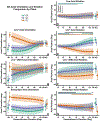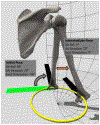Beyond Euler/Cardan analysis: True glenohumeral axial rotation during arm elevation and rotation
- PMID: 33989999
- PMCID: PMC8316370
- DOI: 10.1016/j.gaitpost.2021.05.004
Beyond Euler/Cardan analysis: True glenohumeral axial rotation during arm elevation and rotation
Abstract
Background: Based on Euler/Cardan analysis, prior investigations have reported up to 80° of glenohumeral (GH) external rotation during arm elevation, dependent on the plane of elevation (PoE). However, the subtraction of Euler/Cardan angles does not compute the rotation around the humerus' longitudinal axis (i.e. axial rotation). Clinicians want to understand the true rotation around the humerus' longitudinal axis and rely on laboratories to inform their understanding of underlying shoulder biomechanics, especially for the GH joint since its motion cannot be visually ascertained. True GH axial rotation has not been previously measured in vivo, and its difference from Euler/Cardan (apparent) axial rotation is unknown.
Research question: What is the true GH axial rotation during arm elevation and external rotation, and does it vary from apparent axial rotation and by PoE?
Methods: Twenty healthy subjects (10 M/10 F, ages 22-66) were recorded using biplane fluoroscopy while performing arm elevation in the coronal, scapular and sagittal planes, and external rotation in 0° and 90° of abduction. Apparent GH axial rotation was computed using the xz'y'' and yx'y'' sequences. True GH axial rotation was computed by integrating the projection of GH angular velocity onto the humerus' longitudinal axis. One-dimensional statistical parametric mapping was utilized to compare apparent versus true axial rotation, axial rotation versus 0°, and detect differences in axial rotation by PoE.
Results: In contrast to apparent axial rotation, true GH axial rotation does not differ by PoE and is not different than 0° during arm elevation at higher elevation angles. The spherical area between the sequence-specific and actual humeral trajectory explains the difference between apparent and true axial rotation.
Significance: Proper quantification of axial rotation is important because biomechanics literature informs clinical understanding of shoulder biomechanics. Clinicians care about true axial rotation, which should be reported in future studies of shoulder kinematics.
Keywords: Biplane fluoroscopy; Glenohumeral; Kinematic analysis; True axial rotation.
Copyright © 2021 Elsevier B.V. All rights reserved.
Conflict of interest statement
Conflict of Interest Statement
The authors declare no financial or personal relationships with other people or organizations related to the topic of this research.
Figures






References
-
- Wu G, van der Helm FC, Veeger HE, Makhsous M, Van Roy P, Anglin C, et al., ISB recommendation on definitions of joint coordinate systems of various joints for the reporting of human joint motion--Part II: shoulder, elbow, wrist and hand, Journal of biomechanics 38(5) (2005) 981–992. - PubMed
-
- Norkin CC, White DJ, Measurement of joint motion: a guide to goniometry, FA Davis 2016.
-
- Novotny JE, Beynnon BD, Nichols CE Iii, A numerical solution to calculate internal–external rotation at the glenohumeral joint, Clinical Biomechanics 16(5) (2001) 395–400. http://www.sciencedirect.com/science/article/pii/S0268003301000183. - PubMed
-
- Marshall RN, Elliott BC, Long-axis rotation: the missing link in proximal-to-distal segmental sequencing, Journal of sports sciences 18(4) (2000) 247–54. - PubMed
Publication types
MeSH terms
Grants and funding
LinkOut - more resources
Full Text Sources
Other Literature Sources

